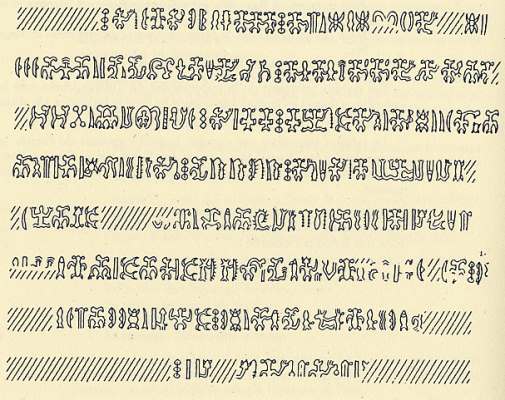
Rongorongo text R
Encyclopedia
Text R of the rongorongo
corpus, the smaller of two tablets in Washington and therefore also known as the Small Washington tablet, is one of two dozen surviving rongorongo texts.
(1958). Fischer (1997) refers to it as RR15.
This piece is commonly known as Atua Mata Riri, after the first name in a chant that Ure Va‘e Iko sang to a photograph of one of Jaussen
's tablets, possibly B or H. The error, if it is one, may be due to a misattribution in the Smithsonian publication of Thomson's book (Fischer).
, Smithsonian Institution
, Washington. Catalog # A129773.
There is a reproduction in the Musée de l'Homme
, Paris.
The Smithsonian catalog says,
Barthel
Fischer
Rongorongo
Rongorongo is a system of glyphs discovered in the 19th century on Easter Island that appears to be writing or proto-writing. It cannot be read despite numerous attempts at decipherment. Although some calendrical and what might prove to be genealogical information has been identified, not even...
corpus, the smaller of two tablets in Washington and therefore also known as the Small Washington tablet, is one of two dozen surviving rongorongo texts.
Other names
R is the standard designation, from BarthelThomas Barthel
Thomas Sylvester Barthel was a German ethnologist and epigrapher who is best known for cataloguing the undeciphered rongorongo script of Easter Island....
(1958). Fischer (1997) refers to it as RR15.
This piece is commonly known as Atua Mata Riri, after the first name in a chant that Ure Va‘e Iko sang to a photograph of one of Jaussen
Florentin-Étienne Jaussen
Monsignor Florentin-Étienne Jaussen was the first bishop of Tahiti and the man who brought the rongorongo script of Easter Island to the world's attention. In the 1860s Bishop Jaussen was responsible for ending the slave raids on Easter Island.Jaussen was born in Rocles, France...
's tablets, possibly B or H. The error, if it is one, may be due to a misattribution in the Smithsonian publication of Thomson's book (Fischer).
Location
Department of Anthropology, National Museum of Natural HistoryNational Museum of Natural History
The National Museum of Natural History is a natural history museum administered by the Smithsonian Institution, located on the National Mall in Washington, D.C., United States. Admission is free and the museum is open 364 days a year....
, Smithsonian Institution
Smithsonian Institution
The Smithsonian Institution is an educational and research institute and associated museum complex, administered and funded by the government of the United States and by funds from its endowment, contributions, and profits from its retail operations, concessions, licensing activities, and magazines...
, Washington. Catalog # A129773.
There is a reproduction in the Musée de l'Homme
Musée de l'Homme
The Musée de l'Homme was created in 1937 by Paul Rivet for the 1937 Exposition Internationale des Arts et Techniques dans la Vie Moderne. It is the descendant of the Musée d'Ethnographie du Trocadéro, founded in 1878...
, Paris.
Physical description
A short, curved, unfluted tablet, 24 × 9 × 1.8 cm, pitted and with one end broken off, made of unknown wood. There is a hole in the middle of the straight edge, probably for hanging. Short segments of the four middle lines have been obliterated on the right side of side b.Provenance
In December 1886, Thomson bought both Washington tablets on Easter Island with the mediation of his Tahitian aide Alexander Salmon "after a great deal of trouble and at considerable expense". He gave both to the Smithsonian in April 1890.The Smithsonian catalog says,
- Catalog Number A129773-0
- Collector(s) Maj. William Judah Thomson
- Collection Date 18 Dec - 31 Dec 1886
- Accession Number 023098
- Donor Name Thomson, William Judah
- Accession Date 1890-Apr-19
- INSCRIBED WOODEN TABLET OBTAINED BY W. J. THOMSON, PAYMASTER OF THE U.S. NAVY SHIP 'MOHICAN' IN EASTER ISLAND, DECEMBER 1886. TABLET WAS PURCHASED FROM MR. A. A. SALMON [a.k.a. Tati Salmon], A EUROPEAN SETTLER AND LONG-TIME RESIDENT OF EASTER ISLAND. THOMSON STATES TABLET IS MADE OF NATIVE TOROMIRO WOOD. TABLET IS DISCUSSED AND ILLUSTRATED IN THE USNM ANNUAL REPORT FOR 1889 (PP. 514, 520, 537). TRANSFERRED FROM ETHNOLOGY TO ARCHEOLOGY ON MAY 2, 1933. FORMERLY ON EXHIBIT NMNH HALL 8, UNIT 4.
- 3 PLASTER CASTS [A129773-1] MADE OF BOTH REVERSE AND OBVERSE SIDES.
- This rongorongo tablet or board is sometimes referred to as the Atua Mata Riri tablet. It is also known as the Small Washington tablet. It is illus. Fig. 48, p. 76, in "Splendid Isolation: Art of Easter Island" by Eric Kjellgren, Metropolitan Museum of Art/Yale University Press, 2001, and identified there as an inscribed tablet (kohau rongorongo).
- From card for 129773-4: "Engraved with shark's tooth. Transferred to Div. Archeology May 2, 1933."
- From second card formerly in Ethnology card file: "No. 129,773: Illus. in USNM AR, 1889; Pl. 38 and 39 [after p. 520]. Translation on p. 520; note on p. 537. Description of acquisition on Easter Island p. 514. Cast made and sent to Musee d' Ethnographic, May, 1933. Loaned to Museum of Modern Art 8-1-84. Returned from Museum of Modern Art 10-4-1985."
Contents
Nearly all of R consists of sequences found in other texts (Pozdniakov and Pozdniakov 2007).Text
Side a has eight lines (Fischer suspects there may once have been nine), and side b nine lines, for ~ 460 glyphs in all. The edges of the tablet are inscribed.Barthel
-

- Side a, as traced by Barthel. The lines have been rearranged to reflect English reading order: Ra1 at top, Ra8 at bottom.
-

- Side b: Rb1 at top, Rb9 (destroyed) at bottom.
Fischer

